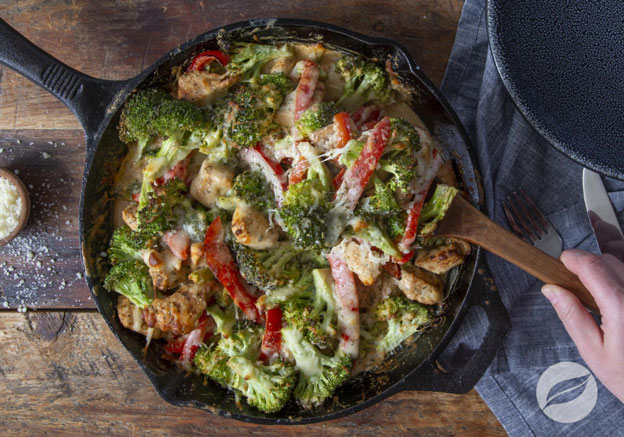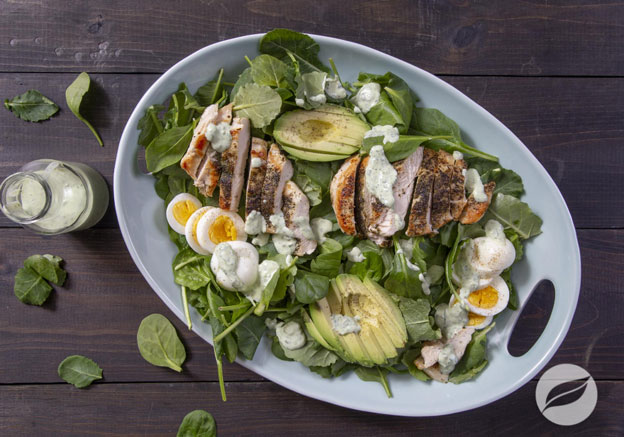What Is The Ketogenic Diet?

- PUBLISHED:
- UPDATED: 03/25/2021
- •
- BY KYMBERLEY PEKRUL
- •
- THIS POST MAY CONTAIN AFFILIATE LINKS
IMPORTANT UPDATE: November 1, 2022
Please note that some ingredient links in this post may have been removed or changed from our original recipe published to reflect new affiliate partnerships.
What is Keto?
The basic idea of the Ketogenic diet, for short “Keto,” is that you get more calories from protein and fat and less from carbohydrates. When you’re on the Keto diet, you cut back most on the easy-to-digest carbs. These are foods like sugar, soda, pastries, pasta, and white bread. This reduction in carbs puts your body into a metabolic state called ketosis.
The history behind the Keto Diet.
During the 1920s, scientists discovered that a diet very high in fat and lacking ample carbohydrates helped treat children with epilepsy. The medical study about it found that, in short, the keto diet works by depriving the body of glucose (found in carbohydrates). When curbed, the lack of glucose forces the body to convert fat into energy, forming ketones to release from your liver. This ketosis process, the metabolic state where the body derives the power it needs from fat instead of carbs, also happens with fasting. Fasting is when the body must rely on fat energy stores.
When first introduced, the parents of children with epilepsy entering their children in the keto diet therapy program received instruction that a strict diet requiring 100% commitment was necessary. The process began with their children being admitted to the hospital for monitoring as they started a fasting period, which produced significant ketones in the body. The next step was to feed the children a very high-fat, low-carb diet. After 1-2 months, many of these children who completed the therapy could reduce their seizure medication. And, although it isn’t entirely known why this diet regimen worked for epilepsy, the patients’ results were very positive.
Losing weight with the Ketogenic Diet and what else Keto is used for.
Fast forward to today, when the “Keto Diet” has become a popular way to lose weight.
After much research and many studies on the diet’s physiological effects on the body, doctors and scientists have found evidence of the diet’s success with weight loss.
One particular study looked at the therapeutic roles and impact of the Keto Diet on obesity/weight loss and managing certain medical conditions. It studied Type 2 diabetes, cardiovascular disease, cancer, polycystic ovary syndrome (PCOS), acne, and nervous system disorders. And the list went on from there, where it concluded that while results are promising, more research is needed. (Article published, June 2013)
Back to weight loss, let's make what was said a little more clear...
Basically,
They’re saying that the study found that weight loss often occurs with the keto diet mainly because people may consume fewer calories on high fat, low carb, high protein diets.
And that’s because…
People on the keto diet have fewer foods to choose from and tend to get full faster with high-fat foods.
Additionally,
The body’s mechanism that pulls energy from fat stores rather than glucose can force the body to lose weight.
But…
All this hasn’t been proven yet.
Sifting through it more, here’s the skinny on what we can take away from the study.
A ketogenic diet may help you lose more weight in the first 3-6 months than some other diets.









So is there a difference between this diet and other carb-reduction diets?
The difference between the Ketogenic Diet and Atkin’s Diet
We already mentioned that the ketogenic diet is similar to Atkin’s Diet. So about now, you might be wondering about the difference between the two.
Both the Atkins diet and the keto diet are carbohydrate-restriction diets, but with one significant difference. The Atkins diet allows more protein than the keto diet. So if you love to eat protein like meats (beef, chicken, lamb, pork, and bacon), and fatty fish like salmon and trout, shrimp and shellfish, eggs, et cetera, with Atkins, you can eat these proteins to your heart’s content.
With Keto, the protein consumed is going to be limited to about 20 percent of daily calories.
Also, Atkins is a four-phase diet with you going through specific periods of deficit. Then periods of maintenance when carbs are involved, which is a big no-no with the keto diet.
With Keto, introducing carbs back would knock the body out of its state of ketosis, as we talked about earlier.
What is better? Keto or Paleo?
Similarly, the paleo diet is still another carb-reduction diet. However, it is not as extreme as the keto diet.
The carbs cut from the paleo diet are crude carb proteins of the modern diet. With the paleo diet, it assumes that what was nutritious and healthy back in the day for hunters and gatherers should also benefit modern humans, too, since we evolved for many thousands of years eating that particular diet.
Essentially, if a hunter/gatherer would have eaten it, you can, too. So paleo permits healthy carbohydrates, like whole vegetables and fruit, but cuts out processed foods.
The keto diet puts more emphasis on fat in the diet. Also, paleo does not anticipate that dieters will go into ketosis, a vital element of the ketogenic diet.

Signup for eNEWS UPDATES + Your FREE Basic Member Pass
♥ RECIPES + RESOURCES STRAIGHT TO YOUR INBOX ♥
Simple and delicious gluten-free recipes, family-friendly meal ideas, healthy cooking, encouragement, and easy-to-implement lifestyle strategies to live fully nourished… Only from GfreeDeliciously!
I promise not to spam you. Pinkie swear!
How the Ketogenic Diet works.
When you eat less than 50 grams of carbs a day, your body eventually runs out of fuel (blood sugar/insulin) that it can quickly use. When stored sugars significantly drop (this typically takes 3 to 4 days), you’ll start to break down protein and fat for energy (the process is called ketosis), making you lose weight.
That may be because it takes more calories to change fat into energy than changing carbs into energy. What’s more, the foods eaten while on the Keto diet are very filling, so you feel more satisfied after eating less, without counting calories or tracking your food intake.
Is the Ketogenic Diet Safe?
Keto diets are popular for people who want to lose weight. But it’s important to note that it is a short-term diet focused on weight loss rather than the pursuit of health benefits.
If you’re interested in starting a ketogenic diet, talk to your doctor to determine if it’s safe for you, especially if you have type 1 diabetes.
Eating a low-carb diet seems to help keep blood sugar lower and more predictable than other diets. But when your body burns fat for energy, it makes compounds called ketones. If you have diabetes, particularly type 1, too many ketones in your blood and low insulin can be very unsafe, making you sick. So it’s crucial to work with your doctor on any changes to your diet.
What are the "Side Effects" of the Ketogenic Diet?
This diet may have adverse side effects on the body, including sensations of nausea, fatigue, headaches, and brain-fogginess, described as the “keto flu,” which, among other symptoms, can also include bad breath and feelings of weakness and irritability.
The good news is that the more common side effects of a Keto diet aren’t usually serious. You might have constipation, mild low blood sugar, or indigestion. Much less often, low-carb diets can lead to kidney stones or high levels of acid in your body (acidosis).
The most important thing to do is Diet With Care.
When your body burns up its stores of fat, it can be very hard on the kidneys. And starting a keto diet — or going back to your regular diet afterward — can be tricky if you’re overweight. This would be because of other health issues you’re likely to have, like diabetes, a heart condition, or high blood pressure. If you know or suspect that you may have any underlying health condition, make diet changes slowly and only with your doctor’s guidance.
Also, the Keto diet is challenging to keep up with over time because it is so restrictive. For most of us, eating a variety of healthy, nutritious foods that we enjoy (including fruits, vegetables, and whole grains) and getting daily exercise will likely be much easier to sustain and a healthier way to live.
POST TAGS:
- ADVERTISEMENT -

Large capacity food processor makes cooking for crowds a snap. Whether you’re mak... [More]

Le Creuset’s cast iron Dutch ovens are perfect for slow cooking, simmering soups ... [More]

Cultivated and cured on the island of Madagascar, each vanilla bean is hand-selected fo... [More]

Now you can check on the accuracy of liquid measures by looking straight down at your c... [More]

Long a fixture in both commercial and home kitchens, KitchenAid’s iconic stand mi... [More]































